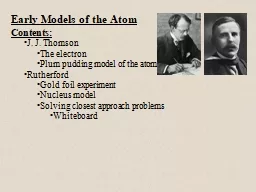

Contents J J Thomson The electron Plum pudding model of the atom Rutherford Gold foil experiment Nucleus model Solving closest approach problems Whiteboard Richard Feynman If in some cataclysm all of scientific knowledge were to be destroyed and only one sentence passed on to t ID: 784404
Download The PPT/PDF document "Early Models of the Atom" is the property of its rightful owner. Permission is granted to download and print the materials on this web site for personal, non-commercial use only, and to display it on your personal computer provided you do not modify the materials and that you retain all copyright notices contained in the materials. By downloading content from our website, you accept the terms of this agreement.
Slide1
Early Models of the AtomContents:J. J. ThomsonThe electronPlum pudding model of the atomRutherfordGold foil experimentNucleus modelSolving closest approach problemsWhiteboard
Slide2Richard Feynman:“If, in some cataclysm, all of scientific knowledge were to be destroyed, and only one sentence passed on to the next generation of creatures, what statement would contain the most information in the fewest words? I believe it is the atomic hypothesis that all things are made of atoms — little particles that move around in perpetual motion, attracting each other when they are a little distance apart, but repelling upon being squeezed into one another. In that one sentence, you will see, there is an enormous amount of information about the world, if just a little imagination and thinking are applied.”
Slide3J.J. Thomson 1856 - 1940Discovers the electron e/m ratio
“Plum Pudding” model
Slide4Ernest Rutherford (1871-1937)Scattering of (an is 2p2n – He nucleus)surprising results:
Slide5Most Alphas are not deflected muchMore deflection closer to nuclei
Slide6Ernest Rutherford (1837-1937)Rutherford’s atom:(It has a nucleus)
But is also has problems:
Why doesn’t the electron radiate energy?
How does this explain the spectral lines they had been observing?
I won’t Bohr you with the solution to this right now…
Size of atoms – you can see E-4 m
cm, mm, .1 mm, 100 papers, 1m paper
100 m paper,
Slide7Nuclear RadiusR - Nuclear radius (m)R
o - Fermi Radius (1.20x10-15 m)A - Mass # (#p +#n)
Example 1:
What is the radius of a Uranium 235 nucleus?
(A = 235)
Slide8Solving closest approachExample 2: What is the closest approach of an alpha particle (m = 6.644x10−27 kg) going 2.6 x 10
6 m/s if it approaches a carbon nucleus head on?
Q
N
Q
p
r
Slide9Solving closest approachExample 3: Through what potential must you accelerate an alpha particle to penetrate a Uranium-235 (Z = 92) nucleus? (r = 7.4 fm) (1 fm = 1x10-15 m)
Q
N
Q
p
r
PE
r
Slide10Solving closest approachEk = 1/2mv2V = W/q, W = VqV = kq/rVqp
= 1/2mv2kinetic = potential
1
/
2
mv
2
= q
p
(kqN
/r)
Example 2: What is the closest approach of an alpha particle (m = 6.644x10−27
kg) going 2.6 x 106 m/s if it approaches a carbon nucleus head on?Ek = 1/2mv2 = 1/2
(6.644x10
−27
kg)(2.6 x 10
6
m/s)
2
= 2.24567E-14 J
PE =
Q
p
(kQ
N
/r), r = Q
p
(kQ
N
/PE) =
(2x1.602E-19)(8.99E9)(6x1.602E-19)/(
2.24567E-14 J
) =
1.23288E-13 m from center of the nucleus
Q
N
Q
p
r
Slide11Solving closest approachEk = 1/2mv2V = W/q, W = VqV = kq/rVqp
= 1/2mv2kinetic = potential
1
/
2
mv
2
= q
p
(kqN
/r)
Example 3: Through what potential must you accelerate an alpha particle to penetrate a Uranium (Z = 92) nucleus? (r = 7.4 fm) (1 fm = 1x10
-15 m).Ek = V(2e) = (2e)(kqN/r) soV = (kqN/r) = (8.99E9)(92*1.602E-19)/(7.4E-15) = 17,905,164.32 V
or about 18 MV
PE
r
Slide12Whiteboards: Closest Approach and Radius1-3
Slide1349 nmMα = 6.644x10−27 kg
Z = 79 for Gold1/2mv2 = Q
p
(kQ
N
/r)
E
k
=
1
/2mv2 = 1/
2(6.644E-27)(15000)2 = 7.4745E-19 J
Ek = (kQN
/r)Qα, r = kQNQα/Ek=
(8.99E9)(79*1.602E-19)(2*1.602E-19)/(
7.4745E-19
)
= 4.87708E-08 m = 49 nm
What is the closest approach in nm of an Alpha particle going 15,000 m/s to a Gold nucleus. (3)
Slide142.75 fmMα = 6.644x10−27 kg
Z = 79 for Gold1/2mv2 = Q
p
(kQ
N
/r)
E
k
=
1
/2mv2 = 1/
2(6.644E-27)(15000)2 = 7.4745E-19 J
Ek = (kQN
/r)Qα, r = kQNQα/Ek=
(8.99E9)(79*1.602E-19)(2*1.602E-19)/(
7.4745E-19
)
= 4.87708E-08 m = 49 nm
What is the radius of a Carbon-12 nucleus?
Slide154.8 MeV1 fm = 1x10-15 mZ = 79Find V at that distance, the alpha energy is twice that in eV because it has twice the charge of an electron.
V = kQ/r = (8.99E9)(79*1.602E-19)/(47E-15) = 2,420,758.34 V = 2.42 MV
so
the alpha energy is 4.84 MeV
An Alpha particle’s closest approach brings it to within 47 fm of a Gold nucleus. What is its energy in eV (3)